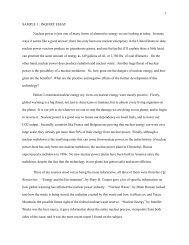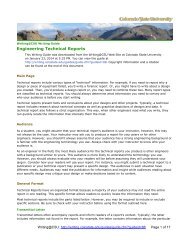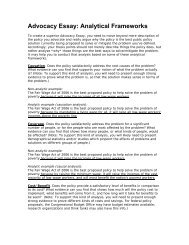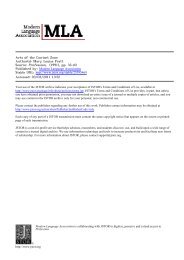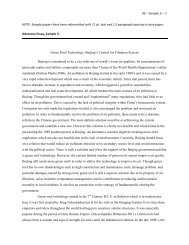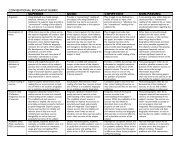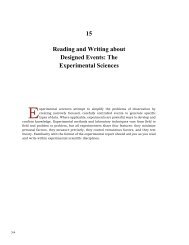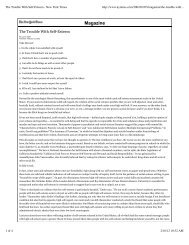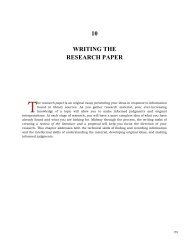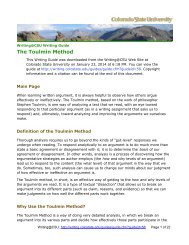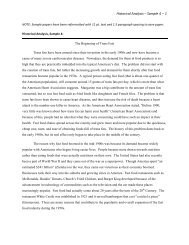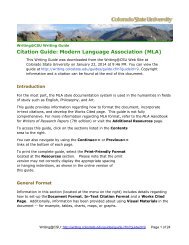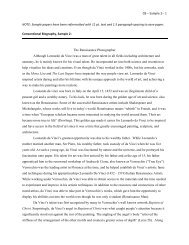Helping Students Use Textual Sources Persuasively Margaret Kantz ...
Helping Students Use Textual Sources Persuasively Margaret Kantz ...
Helping Students Use Textual Sources Persuasively Margaret Kantz ...
Create successful ePaper yourself
Turn your PDF publications into a flip-book with our unique Google optimized e-Paper software.
80 College English<br />
type of discourse may pertain more to a particular point of the triangle than to<br />
the others, e.g., a diary entry may exist primarily to express the thoughts of the<br />
writer (the Encoder); an advertisement may exist primarily to persuade a reader<br />
(the Decoder). Following Kinneavy, I posit particular goals for each corner of<br />
the triangle. Thus, the primary goal of a writer doing writer-based discourse<br />
such as a diary might be originality and self-expression; primary goals for<br />
reader-based discourse such as advertising might be persuasion; primary goals<br />
for topic-based discourse such as a researched essay might be accuracy, completeness,<br />
and mastery of subject matter. Since all three aspects of the rhetorical<br />
situation are present and active in any communicative situation, a primarily referential<br />
text such as Churchill's The Birth of Britain may have a persuasive purpose<br />
and may depend for some of its credibility on readers' familiarity with the<br />
author. The term "rhetorical reading," then (cf. Haas and Flower), means<br />
teaching students to read a text as a message sent by someone to somebody for a<br />
reason. Shirley, Mary, and Charlie are probably practiced users of rhetorical<br />
persuasion in non-academic contexts. They may never have learned to apply this<br />
thinking in a conscious and deliberate way to academic tasks (cf. Kroll).<br />
The concept of rhetorical situation offers insight into the nature of students'<br />
representations of a writing task. The operative goals in Shirley's and Alice's approaches<br />
to the term paper look quite different when mapped onto the points on<br />
the triangle. If we think of Shirley and Alice as Encoders, the topic as Reality,<br />
and Dr. Boyer as the Decoder, we can see that for Shirley, being an Encoder<br />
means trying to be credible; her relationship to the topic (Reality) involves a goal<br />
of using all of the subject matter; and her relationship to the Decoder involves an<br />
implied goal of telling a complete story to a reader whom Shirley thinks of as an<br />
examiner-to use the classic phrase from the famous book by Britton et a1.-<br />
i.e., a reader who wants to know if Shirley can pass an exam on the subject of<br />
the Battle of Agincourt. For Alice, however, being an Encoder means having a<br />
goal of saying something new; the topic (Reality) is a resource to be used; and<br />
the Decoder is someone who must be persuaded that Alice's ideas have merit.<br />
Varying task representations do not change the dimensions of the rhetorical situation:<br />
the Encoder, Decoder, and Reality are always present. But the way a<br />
writer represents the task to herself does affect the ways that she thinks about<br />
those dimensions-and whether she thinks about them at all.<br />
In the context of a research assignment, rhetorical skills can be used to read<br />
the sources as well as to design the paper. Although teachers have probably always<br />
known that expert readers use such strategies, the concept of rhetorical<br />
reading is new to the literature. Haas and Flower have shown that expert readers<br />
use rhetorical strategies "to account for author's purpose, context, and effect<br />
on the audience . . . to recreate or infer the rhetorical situation of the text"<br />
(176; cf. also Bazerman). These strategies, used in addition to formulating main<br />
points and paraphrasing content, helped the readers to understand a text more<br />
completely and more quickly than did readers who concentrated exclusively on<br />
content. As Haas and Flower point out, teaching students to read rhetorically is<br />
difficult. They suggest that appropriate pedagogy might include "direct instruction<br />
. . . modeling, and . . . encouraging students to become contributing and



